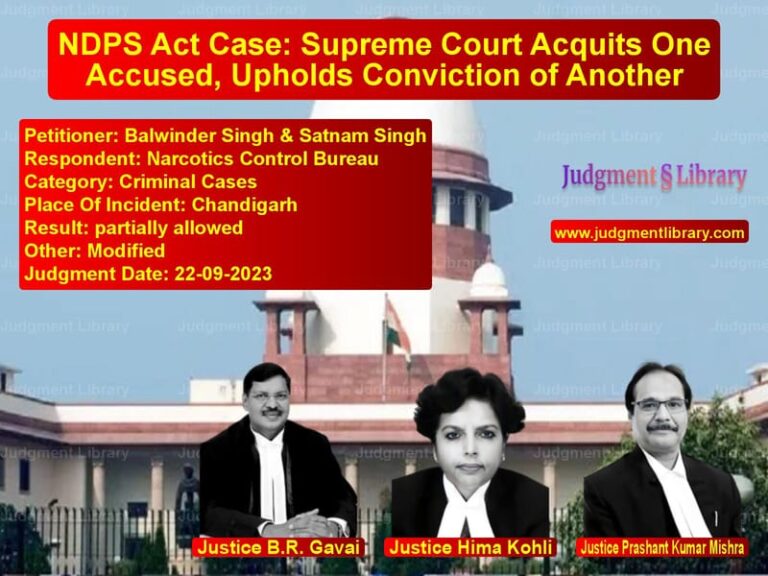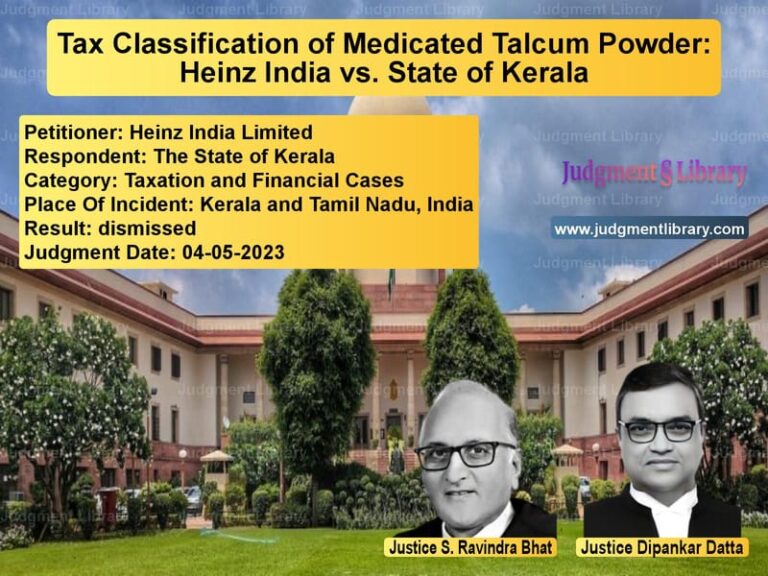Forest Land Dispute: Supreme Court Defines Legal Status of Haryana Land Under PLPA
The Supreme Court of India delivered a significant ruling in **Narinder Singh & Ors. vs. Divesh Bhutani & Ors.**, addressing the **legal status of lands covered under the Punjab Land Preservation Act, 1900 (PLPA)** and whether they qualify as **forest lands under the Forest (Conservation) Act, 1980 (the 1980 Forest Act).** The case has profound implications on land use regulations, environmental protection, and the rights of private landowners.
Background of the Case
The dispute arose from multiple civil appeals and writ petitions challenging **National Green Tribunal (NGT) orders** that categorized lands covered under Section 4 of the **PLPA as ‘forest lands’** under the 1980 Forest Act. The lands in question, located in **Ballabhgarh, Faridabad (Haryana),** were subject to restrictions imposed under PLPA, impacting businesses operating on them.
The petitioners included **owners of marriage halls, restaurants, and private establishments** affected by the classification of their land as forest areas. The NGT had issued restraining orders preventing **non-forest activities** on the disputed lands. The appellants contested these restrictions, arguing that lands covered by **PLPA orders are not automatically forest lands under the 1980 Forest Act.**
Petitioner’s Arguments
The petitioners, represented by senior advocates, contended:
- PLPA is **not a forest law**; rather, it was enacted for soil conservation and preventing erosion.
- Lands classified under **Section 4 of PLPA** cannot automatically be deemed **forest lands under the 1980 Forest Act.**
- Forest land must be classified under the **Indian Forest Act, 1927**, which follows a different procedure.
- The affected businesses were **established before 1992**, when the Haryana government issued orders under PLPA.
- The Supreme Court’s previous rulings in **T.N. Godavarman Thirumulpad v. Union of India** and **M.C. Mehta cases** did not explicitly define PLPA lands as forests.
- The NGT’s interpretation of forest laws **violates property rights** and creates unnecessary restrictions.
Respondent’s Arguments
The State of Haryana and environmental groups countered:
- The lands covered under **Section 4 and 5 of PLPA** have all the characteristics of a forest.
- The **1980 Forest Act overrides PLPA**, and any land with forest-like features should be protected.
- The state government had historically recorded these lands as **forests in official records.**
- Granting relief to the petitioners would **set a dangerous precedent, allowing deforestation in ecologically sensitive areas.**
- The petitioners **failed to challenge the classification for decades**, making their claims invalid due to delay.
Supreme Court’s Observations
The Supreme Court analyzed the legal status of lands notified under **PLPA** and examined its interaction with the **Forest Conservation Act, 1980.** Key observations included:
- PLPA was enacted primarily for **soil conservation and preventing erosion, not as a forest law.**
- However, the court noted that **some lands covered under Section 4 of PLPA could qualify as forests** if they met the definition set in **T.N. Godavarman’s case.**
- Government records designating land as **forest carry significant weight**, but **historical usage must also be considered.**
- The **State of Haryana had taken contradictory positions** over the years regarding whether PLPA lands constituted forests.
- The **NGT overstepped its jurisdiction** by imposing blanket restrictions without assessing individual cases.
Key Legal Precedents Considered
The Supreme Court referred to several landmark rulings:
- T.N. Godavarman Thirumulpad v. Union of India (1997): Defined forests beyond statutory classifications, including those with forest-like characteristics.
- M.C. Mehta v. Union of India (2004, 2008): Addressed the scope of environmental protection and government responsibilities in maintaining forest cover.
- B.S. Sandhu v. Government of India (2014): Clarified that **PLPA notifications do not automatically convert land into forests** under the 1980 Forest Act.
- Vijay Bansal v. State of Haryana (2009): Recognized **PLPA lands as forest land for regulatory purposes** but did not conclusively determine their permanent status.
Final Judgment
The Supreme Court ruled:
- Lands notified under **Section 4 of PLPA have characteristics of forest lands and will be treated as such under the 1980 Forest Act.**
- Any **non-forest activity on these lands requires prior approval from the Central Government** as per **Section 2 of the 1980 Act.**
- However, the **blanket classification of all PLPA lands as forests is incorrect**, and a case-by-case assessment is needed.
- The **NGT’s orders were modified**, allowing authorities to **evaluate individual cases before imposing restrictions.**
- Owners of lands covered under **PLPA can apply for exemption or reclassification** under the law.
Implications of the Ruling
This judgment has far-reaching consequences for land regulation, environmental protection, and property rights:
- **Greater clarity** on how PLPA lands are classified under **forest laws.**
- Property owners **cannot assume unrestricted land use**, even if they previously had businesses operating there.
- Authorities **must assess environmental impact before allowing construction or commercial activities.**
- Strengthens **government oversight on forest conservation** while balancing property rights.
The ruling underscores the **need for sustainable development** while ensuring that **forest conservation remains a priority.** Landowners and businesses in affected areas must now seek **government clearance before engaging in non-forest activities.**
Petitioner Name: Narinder Singh & Ors..Respondent Name: Divesh Bhutani & Ors..Judgment By: Justice A. M. Khanwilkar, Justice Abhay S. Oka, Justice C. T. Ravikumar.Place Of Incident: Faridabad, Haryana.Judgment Date: 20-07-2022.
Don’t miss out on the full details! Download the complete judgment in PDF format below and gain valuable insights instantly!
Download Judgment: narinder-singh-&-ors-vs-divesh-bhutani-&-ors-supreme-court-of-india-judgment-dated-20-07-2022.pdf
Directly Download Judgment: Directly download this Judgment
See all petitions in Fundamental Rights
See all petitions in Public Interest Litigation
See all petitions in Constitution Interpretation
See all petitions in Judgment by A M Khanwilkar
See all petitions in Judgment by Abhay S. Oka
See all petitions in Judgment by C.T. Ravikumar
See all petitions in partially allowed
See all petitions in Modified
See all petitions in supreme court of India judgments July 2022
See all petitions in 2022 judgments
See all posts in Environmental Cases Category
See all allowed petitions in Environmental Cases Category
See all Dismissed petitions in Environmental Cases Category
See all partially allowed petitions in Environmental Cases Category






